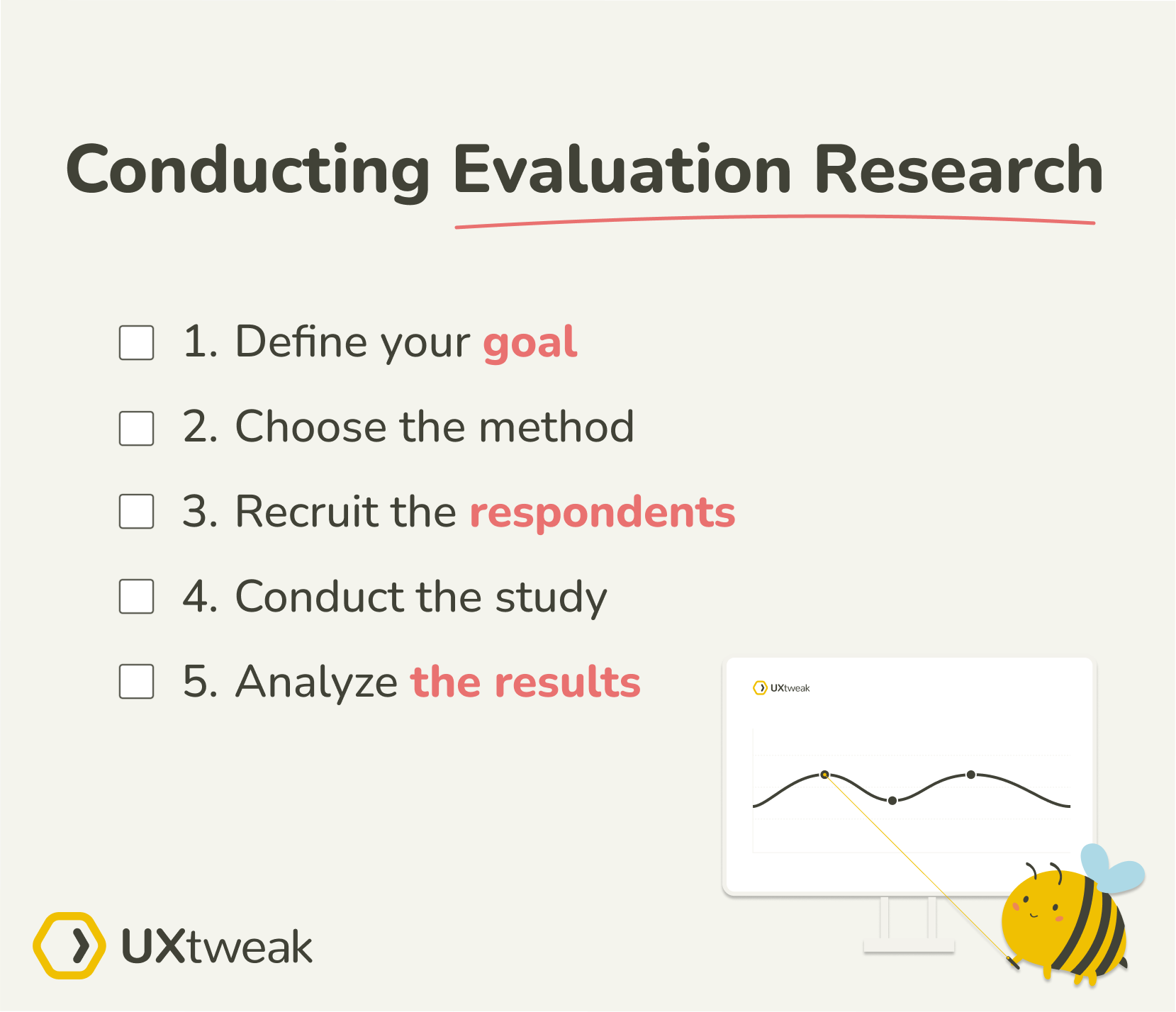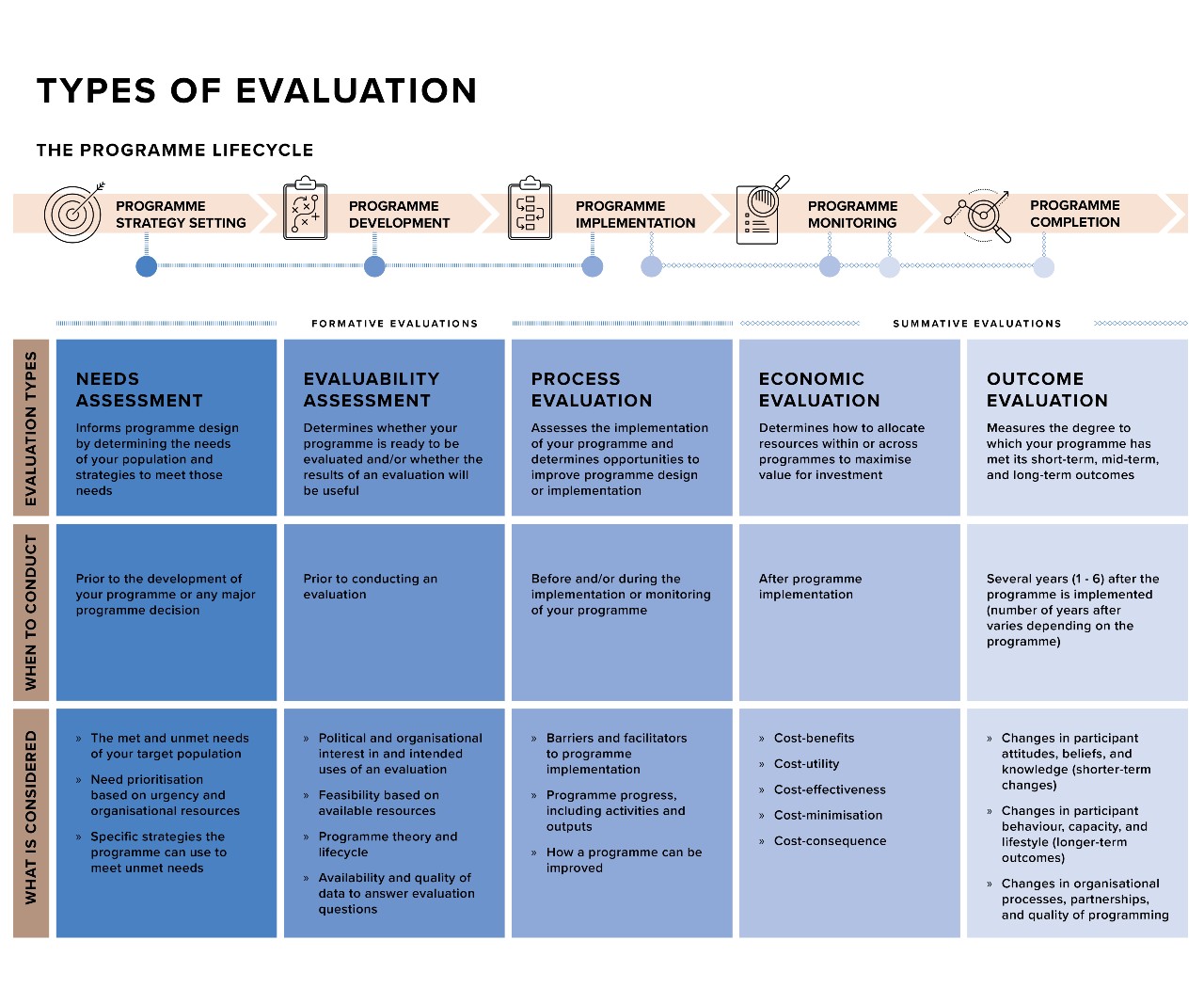Table Of Content
- Development of the Framework for Developing and Evaluating Complex Interventions
- Concerns research designs should address
- Selecting Impact/Outcome Evaluation Designs: A Decision-Making Table and Checklist Approach
- The elements of key importance to be sure that the recommendations from an evaluation are used are:

Surveillance is the continuous monitoring or routine data collection on various factors (e.g., behaviors, attitudes, deaths) over a regular interval of time. Data gathered by surveillance systems are invaluable for performance measurement and program evaluation, especially of longer term and population-based outcomes. In addition, these data serve an important function in program planning and “formative” evaluation by identifying key burden and risk factors—the descriptive and analytic epidemiology of the public health problem. Also, these surveillance systems may have limited flexibility to add questions for a particular program evaluation. If the programme theory suggests that contextual or implementation factors might influence the acceptability, effectiveness, or cost effectiveness of the intervention, these questions should be considered.
Development of the Framework for Developing and Evaluating Complex Interventions
Additionally, efforts should be made to develop gamified online role-play in asynchronous learning approaches to enhance the flexibility of learning activities. Albeit the robust design and data collection tools to assure reliability and validity as well as transparency of this study, a few limitations were raised leading to a potential of further research. More learning scenarios in other dental specialties should also be included to validate its effectiveness, as different specialties could have different limitations and variations. Additional learning scenarios from various dental disciplines should be considered to validate the effectiveness of gamified online role-plays, as different specialties may present unique limitations and variations. A randomized controlled trial with robust design should be required to compare the effectiveness of gamified online role-play with different approaches in training the use of teledentistry. The pedagogical components comprised learning content, which was complemented by assessment and feedback.
E-Learning Path on Evaluation Management UNSSC - United Nations System Staff College
E-Learning Path on Evaluation Management UNSSC.
Posted: Wed, 08 Nov 2023 03:51:29 GMT [source]
Concerns research designs should address
The resource addresses evaluation design criteria, information requirements, performance measures, evaluation panels, as well as development and implementation of evaluation plans. It begins by emphasizing that there is no one-size-fits-all design for evaluations, as it depends on factors such as the context, time constraints, existing information, and available resources. That circumstance can raise some of the same problems related to selection seen when there is no control group. If the only potential comparisons involve very different groups, it may be better to use a design, such as an interrupted time series design that doesn’t involve a control group at all, where the comparison is within (not between) groups.
Selecting Impact/Outcome Evaluation Designs: A Decision-Making Table and Checklist Approach
Note that in each phase, the focus of your evaluation expands to include more domains of your ToC. In a pilot study, in addition to data on targets (your primary focus), you’ll want to gather information on strategies to continue looking at feasibility and acceptability. One of the first considerations of any evaluation design has to do with the timing of the evaluation.
How do you evaluate a specific program?
Product evaluation will often require careful scrutiny of available data relating to the function and appearance of the product, while the design of an evaluation of an employee or even an ongoing project will consider information that is somewhat different. Typically, any evaluation design will seek to include data that is specifically relevant to the subject and then pursue a process that is likely to produce a result that is of use to the operation. Participants believed that they could realize the necessity of teledentistry from the gamified online role-play. The storytelling or patient conditions allowed learners to understand how teledentistry could have both physical and psychological support for dental patients.
Sign up for the Dummies Beta Program to try Dummies' newest way to learn.

For complex intervention research to be most useful to decision makers, it should take into account the complexity that arises both from the intervention’s components and from its interaction with the context in which it is being implemented. Other key indicators of performance measurement include user-satisfaction, organizational capacity, market penetration, and facility utilization. In carrying out performance measurement, organizations must identify the parameters that are relevant to the process in question, their industry, and the target markets. Appreciative inquiry is a type of evaluation research that pays attention to result-producing approaches.
What is Program Evaluation?: A Beginners Guide
Periodic cross-sectional surveys (e.g.., the YTS or BRFSS) can inform your evaluation. Case studies may be particularly appropriate for assessing changes in public health capacity in disparate population groups. Case studies are applicable when the program is unique, when an existing program is used in a different setting, when a unique outcome is being assessed, or when an environment is especially unpredictable.
Using Effective Tools for Evaluation Design
Furthermore, she was designated to encounter difficulties with the technological use of the teledentistry platform. This often comes into play after the evaluation is completed and the data are interpreted. To understand, not only how the program impacted the target population, but whether the program could be applicable outside of its current setting.
Despite an increased understanding of the need for - and the use of - evaluation, however, a basic agreed-upon framework for program evaluation has been lacking. In 1997, scientists at the United States Centers for Disease Control and Prevention (CDC) recognized the need to develop such a framework. As a result of this, the CDC assembled an Evaluation Working Group comprised of experts in the fields of public health and evaluation. Members were asked to develop a framework that summarizes and organizes the basic elements of program evaluation. This Community Tool Box section describes the framework resulting from the Working Group's efforts. Note that in either scenario, you must also consider questions of interest to key stakeholders who are not necessarily intended users of the results of the current evaluation.
Albeit the benefits of teledentistry, available evidence demonstrates challenges and concerns in the implementation of telehealth. Lack of awareness and knowledge in the use of telehealth can hinder the adoption of telehealth13. Legal issues and privacy concerns also emerge as significant challenges in telehealth use14.
With these and your previously determined focus criteria you can now create specific questions focused on aspects of the program's impact and implementation. This article from Paul Duignan is aimed at supporting evaluators decide which impact/outcome evaluation design is most appropriate to use. A decision-making table approach is provided to assist in the selection of one of the seven possible groups of impact/outcome evaluation. Asking these same kinds of questions as you approach evidence gathering will help identify ones what will be most useful, feasible, proper, and accurate for this evaluation at this time. Thus, the CDC Framework approach supports the fundamental insight that there is no such thing as the right program evaluation. Rather, over the life of a program, any number of evaluations may be appropriate, depending on the situation.
Similarly, program opponents may misuse results by overemphasizing negative findings without giving proper credit for what has worked. Active follow-up can help to prevent these and other forms of misuse by ensuring that evidence is only applied to the questions that were the central focus of the evaluation. Forming recommendations requires information beyond just what is necessary to form judgments. For example, knowing that a program is able to increase the services available to battered women doesn't necessarily translate into a recommendation to continue the effort, particularly when there are competing priorities or other effective alternatives. Thus, recommendations about what to do with a given intervention go beyond judgments about a specific program's effectiveness. It is necessary to estimate in advance the amount of information that will be required and to establish criteria to decide when to stop collecting data - to know when enough is enough.
An evaluator's challenge is to devise an optimal strategy, given the conditions she is working under. An optimal strategy is one that accomplishes each step in the framework in a way that takes into account the program context and is able to meet or exceed the relevant standards. Along with the uses for evaluation findings, there are also uses that flow from the very process of evaluating. The people who take part in an evaluation can experience profound changes in beliefs and behavior. For instance, an evaluation challenges staff members to act differently in what they are doing, and to question assumptions that connect program activities with intended effects.

They also recommended to design the gamified online role-play to have different levels where learners could select an option that is suitable for them. All participants were asked to complete the satisfaction questionnaire after participating in the gamified online role-play, to investigate whether or not they felt satisfied with their learning (Supplementary material 2). The questionnaire was developed based on previous literature regarding gamification and role-play41,42,43,44. Most of the items were designed using a 5-point Likert scale, where 1 being ‘very dissatisfied’ and 5 being ‘very satisfied’.
Was there an issue with acceptability, and participants tended to skip sessions or drop out of the program early? Maybe the implementation went smoothly, but the strategies just weren’t effective at changing your targets, and that’s where the causal chain broke down. Unless you gather data on strategies and targets, it’s hard to know what went wrong and what you can do to improve the program’s effectiveness.
Remember, the standards are written as guiding principles, not as rigid rules to be followed in all situations. Evaluation also prompts staff to clarify their understanding of the goals of the program. This greater clarity, in turn, helps staff members to better function as a team focused on a common end. In short, immersion in the logic, reasoning, and values of evaluation can have very positive effects, such as basing decisions on systematic judgments instead of on unfounded assumptions.
No comments:
Post a Comment